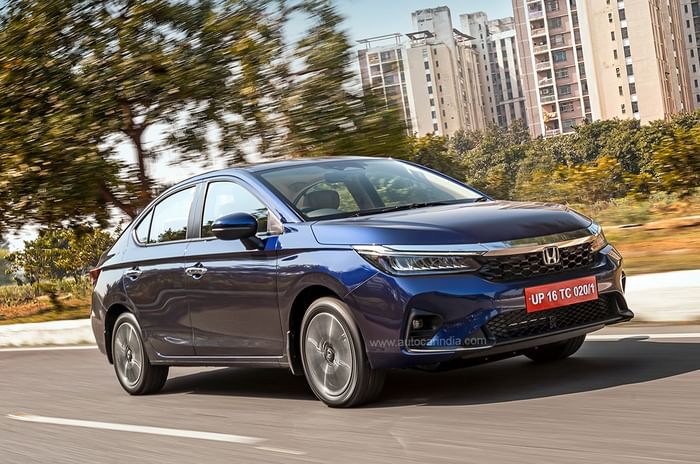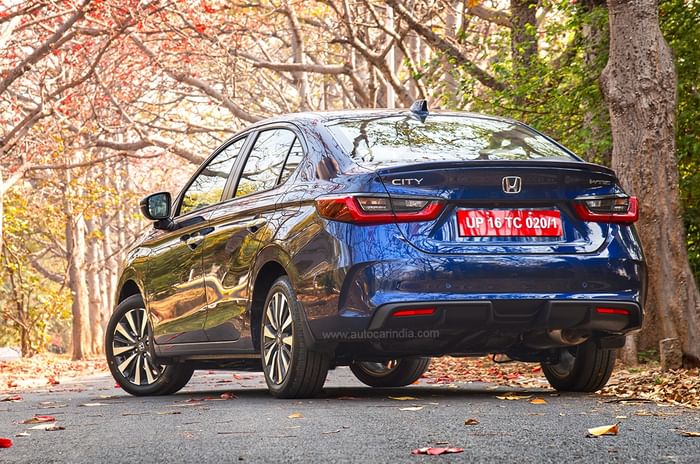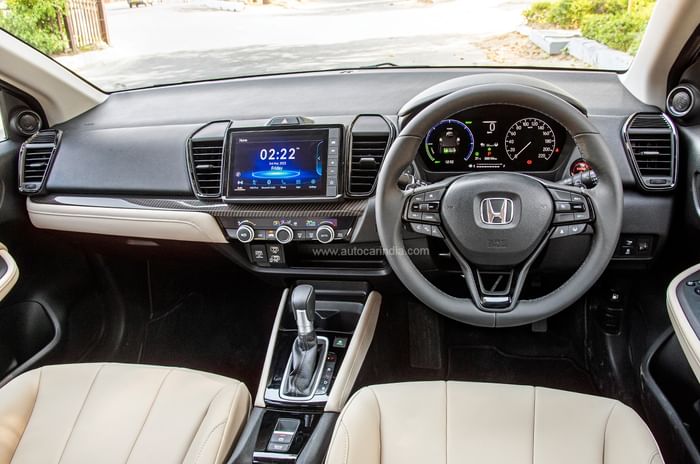Honda City facelift review: ADAS at your service
Honda’s bestselling midsize sedan gets a makeover, segment-first ADAS and more.
Published on Mar 09, 2023 11:00:00 AM
41,595 Views
Follow us on



We Like
- Well-rounded performance
- Space and comfort
- Segment-first ADAS
We Don't Like
- Hybrid's pricing
- Misses ventilated seats
To meet the soon-to-be-implemented Real Driving Emissions (RDE) norms and make its engine compatible with E20 fuel (20 percent ethanol blended petrol), Honda recently updated the petrol and hybrid versions of the City. Three years after its launch, the Japanese carmaker has also given this segment’s bestseller a makeover, introduced more affordable variants for both petrol and hybrid, and also added some new features. After a price hike of up to Rs 50,000 across the range, the petrol City is now priced between Rs 11.49 lakh-15.97 lakh, while the hybrid is priced between Rs 18.89 lakh-20.39 lakh.
But with the facelift, Honda has also pulled the plug on its frugal diesel engine. According to Honda, due to the shift in consumer preference from diesel to petrol, the City diesel, in recent times, accounted for less than ten percent of total sales. Hence, the numbers didn’t justify the investment to upgrade this powertrain to meet RDE norms. The company has also discontinued the fourth-generation City, which sold alongside the fifth-gen.
Honda City facelift: exteriors
 The City now gets a reworked grille and a new design for the 16-inch alloy wheels.
The City now gets a reworked grille and a new design for the 16-inch alloy wheels.
| Honda City Price, Mileage, Specifications, Features and Variants | |
|---|---|
| Brand | Honda |
| Model Name | City |
| Honda City Price | ₹ 14.34 - 24.12 lakh |
| Honda City Range/Mileage | Petrol Hybrid : 27.13kpl | Petrol : 17.8 - 18.4kpl |
| Honda City Specifications | Sedan | 4 doors | 5 seats View All Specs |
| Honda City Features | LED headlight | 8-inch Touchscreen display | 6 airbags View All Features |
| Honda City Variants | 1.5 Petrol SV MT | 1.5 Petrol V MT | 1.5 Petrol VX MT View All Variants |
For this 2023 facelift, subtle styling tweaks freshen up its appeal. The chrome on its new grille is toned down and is more tastefully executed than the chunky slab of the pre-facelift iteration. And the attractive LED headlamps, coupled with just the right amount of bling, nicely complement the Obsidian Blue Pearl paint, which is a new, elegant addition to its colour palette.
 Aggressive rear diffuser with a carbon-fibre-like pattern looks quite convincing.
Aggressive rear diffuser with a carbon-fibre-like pattern looks quite convincing.
The front and rear bumpers have been restyled across the range, but only the higher variants are treated with dollops of aggression that add to its sporty pretence. Part of this includes black plastic trims surrounding the fog-lamp housings, along with both bumper lip and a beefy rear diffuser in a carbon-fibre-like pattern, which looks so convincing that it could pass muster in a more accomplished sportscar.
 Boot lip spoiler, which was only reserved for the hybrid, is now offered with the top-spec petrol.
Boot lip spoiler, which was only reserved for the hybrid, is now offered with the top-spec petrol.
The 16-inch alloys are also new, however, the City continues with skinny 185/55 R16 tyres; wider tyres would have completed the look of this otherwise well-proportioned sedan. With the facelift, even the petrol version gets a boot lip spoiler, which was earlier offered only on the hybrid. And with that, there’s little visual differentiation between the petrol and the hybrid version – the hybrid gets Honda logos (front and back) bordered in blue, an “e:HEV” badge on the boot, and rear disc brakes.
Honda City facelift: interiors
 Seats remain plush and supportive; ventilated seats would have enhanced comfort.
Seats remain plush and supportive; ventilated seats would have enhanced comfort.
The petrol version’s interior remains virtually unchanged save for some new feature additions. In place of the front cupholders (ahead of the gear lever) sits a detachable wireless charging pad, which can be tucked into the glovebox when not in use. Then, there are the ADAS-specific changes, which include buttons on the steering wheel and displays on the part-digital instrument cluster.
 Detachable wireless charging pad (in the petrol) rests in place of the front cupholders. Can be stowed in the glovebox when not in use.
Detachable wireless charging pad (in the petrol) rests in place of the front cupholders. Can be stowed in the glovebox when not in use.
New to the hybrid version is a carbon-fibre like trim, which replaces the wooden trim panel on the dashboard. Its wireless charging pad, which was an accessory earlier, is now part of the package and rests in place of the petrol’s handbrake – the hybrid gets an electronic parking brake.
 Touchscreen software has been updated and resolution has improved; packs in wireless smartphone integration.
Touchscreen software has been updated and resolution has improved; packs in wireless smartphone integration.
After receiving feedback from various stakeholders, the 8-inch touchscreen has been updated with newer software and better resolution. While the user interface is still rather basic, it finally packs in wireless Android Auto and Apple CarPlay.
 Reversing camera display and blind spot monitor are easier to view thanks to the screen's better resolution.
Reversing camera display and blind spot monitor are easier to view thanks to the screen's better resolution.
Another key improvement is the rear camera display and blindspot monitor display, which is brighter and easier to view than the earlier iteration. However, ventilated front seats are still missing from the equipment list.
 Rear seats are comfy and offer good legroom.
Rear seats are comfy and offer good legroom.
Honda hasn’t made other changes to this well-appointed cabin, which isn’t a bad thing, as certain bits still feel high quality, like the climate control knobs, the excellent instrument cluster as well as the plush and supremely comfortable seats. The boot is large on the petrol, although the hybrid’s is a bit compromised due to the position of the secondary battery.
Honda City facelift: ADAS
Trickling down from the Hybrid version to the standard petrol are Honda’s camera-based autonomous driver assistance systems (ADAS), which include lane-keeping assist, lane departure warning, adaptive cruise control, autonomous emergency braking, collision mitigation braking system and automatic high-beam assist.
 ADAS safety tech on the City facelift includes automatic brake assist.
ADAS safety tech on the City facelift includes automatic brake assist.
The lane-keeping assist function detects when the vehicle is veering off its lane, and the system will warn the driver and even make corrective steering adjustments to get back into the lane. This feature works only above 67kph, and the system is neither too aggressive nor intrusive, making it work nicely on well-marked roads.
Like cruise control, adaptive cruise control maintains a preset speed, but it goes a step further and maintains a preset distance and adjusts speed with the vehicle in front. It will even bring the vehicle down to a complete halt, and pick up speed automatically thereafter. Occasionally, however, the system tends to decelerate a bit abruptly when the vehicle in front is driving erratically or when other motorists cut you off, so it’s best used on a wide, open highway where traffic is scant.
 Lane keep assist feature works only above 67kph; works nicely on well-marked roads.
Lane keep assist feature works only above 67kph; works nicely on well-marked roads.
Honda even offers this on the manual version, however, it comes with certain challenges. The driver needs to ensure the car is in the right gear, and when the system reduces the car’s speed based on the vehicle in front, if conditions like load, engine speeds, road angle and so on are not met, the feature will automatically disengage and won't rebuild momentum when the vehicle in front accelerates or clears the way.
New with this update is a ‘lead car departure notification system’, which comes in handy at a red light or in bumper-to-bumper traffic, where it emits an audio beep and throws up a prompt on the instrument cluster to intimate the driver when the vehicle ahead has moved and the road is clear for you to roll ahead.
Honda City facelift: performance
With this update, some components of its petrol and hybrid powertrain have been upgraded to be compatible with E20 fuel, which will soon be available across the country.
 The RDE-compliant 1.5-litre petrol engine puts out the same 121hp and 145Nm.
The RDE-compliant 1.5-litre petrol engine puts out the same 121hp and 145Nm.
Its 1.5-litre petrol engine remains as likeable as before, with no change to the power or torque output. It is quite responsive at low speeds, and while this naturally aspirated engine’s mid-range performance is expectedly flattish (unlike a turbo-petrol), it is an engine which loves to be spun fast. Power flows in steps, with prominent spikes felt beyond 2,000rpm and 4,000rpm. However, it is closer to its 7,000rpm rev limiter where it feels the most enjoyable, not only in terms of performance, but also the aural experience.
Interestingly, over 50 percent of City's sales in India are automatics, which isn’t a surprise because of how effortless yet surprisingly efficient its continuously variable transmission (CVT) is. It does its job in a fuss-free and relaxed manner. But for those who enjoy rowing through the gates manually, the 6-speeder too makes light work of driving on account of its smooth and well-defined gates and its light clutch.
 The City offers the most fun and performance at the 7,000rpm mark,
The City offers the most fun and performance at the 7,000rpm mark,
The other powertrain option in the City range is the hybrid or “e:HEV”, which comprises a 1.5-litre Atkinson cycle petrol engine and two electric motors – a 109hp traction motor that draws its energy from a lithium-ion battery to power the wheels and a 95hp motor-generator that charges the battery using the petrol engine.
The hybrid’s intelligent system automatically toggles between its three drive modes – Electric, Hybrid and Engine, based on various parameters. The transition between the modes is seamless, the engine is refined and vibe free, and, in addition to being far more responsive (than the standard petrol) thanks to the electric assist on offer, it also delivers staggering fuel efficiency, which is likely to hover around the 20kpl mark in city and highway driving conditions.
Honda City facelift: ride and handling
 The City offers a confidence-inspiring drive courtesy of the weighted steering and compliant ride.
The City offers a confidence-inspiring drive courtesy of the weighted steering and compliant ride.
The City drives in a confidence-inspiring manner and cushions passengers from the rough stuff with a great sense of maturity. Stability is good too, and thanks to its well-weighted steering and predictable nature, there’s a degree of fun you can have while hustling this car around. What could have been improved, however, is the cabin insulation and refinement, which aren’t as good as some of its rivals. So, like before, you can hear a lot of engine and road noise seeping into the cabin.
Honda City facelift: price and verdict
Honda is commanding an eye-watering Rs 4.50 lakh-5.00 lakh premium for the Hybrid over comparable petrol-automatic variants. Even though the company has introduced an additional, more affordable hybrid variant, this high-tech iteration is likely to be a hard sell, especially because the petrol-CVT is equally equipped, offers good performance and is quite fuel-efficient too.
The regular City is priced similar to the 1.0 turbo-petrol variants of the Volkswagen Virtus and Skoda Slavia; albeit higher than the Maruti Ciaz. The facelift is very mild and does miss out on a few features and that’s something its soon to arrive rival – the new Hyundai Verna – will likely be loaded with, but it gets the basics right. For the money, the updated Honda City continues to be a well-rounded sedan, packing in everything buyers are looking for – space, comfort, fuel efficiency and to top it off, reasonably fun to drive. What will add to its appeal, for some, is the first-in-segment autonomous driver assistance systems (ADAS). So, if you’re looking at the City, the Hybrid is really only for those who want the latest in tech or for those who drive a whole lot more. For everyone else, the regular City will do just fine.
Also see:
Honda City facelift video review
Tech Specs 
Copyright (c) Autocar India. All rights reserved.



.jpg?w=234&h=156&q=90&c=1)
.jpg?w=234&h=156&q=90&c=1)
 Price
Price Engine
Engine Transmission
Transmission Efficiency
Efficiency Body
Body Suspension
Suspension Steering
Steering Brakes
Brakes Dimensions
Dimensions
Comments
Member Login
Personal Details
No comments yet. Be the first to comment.